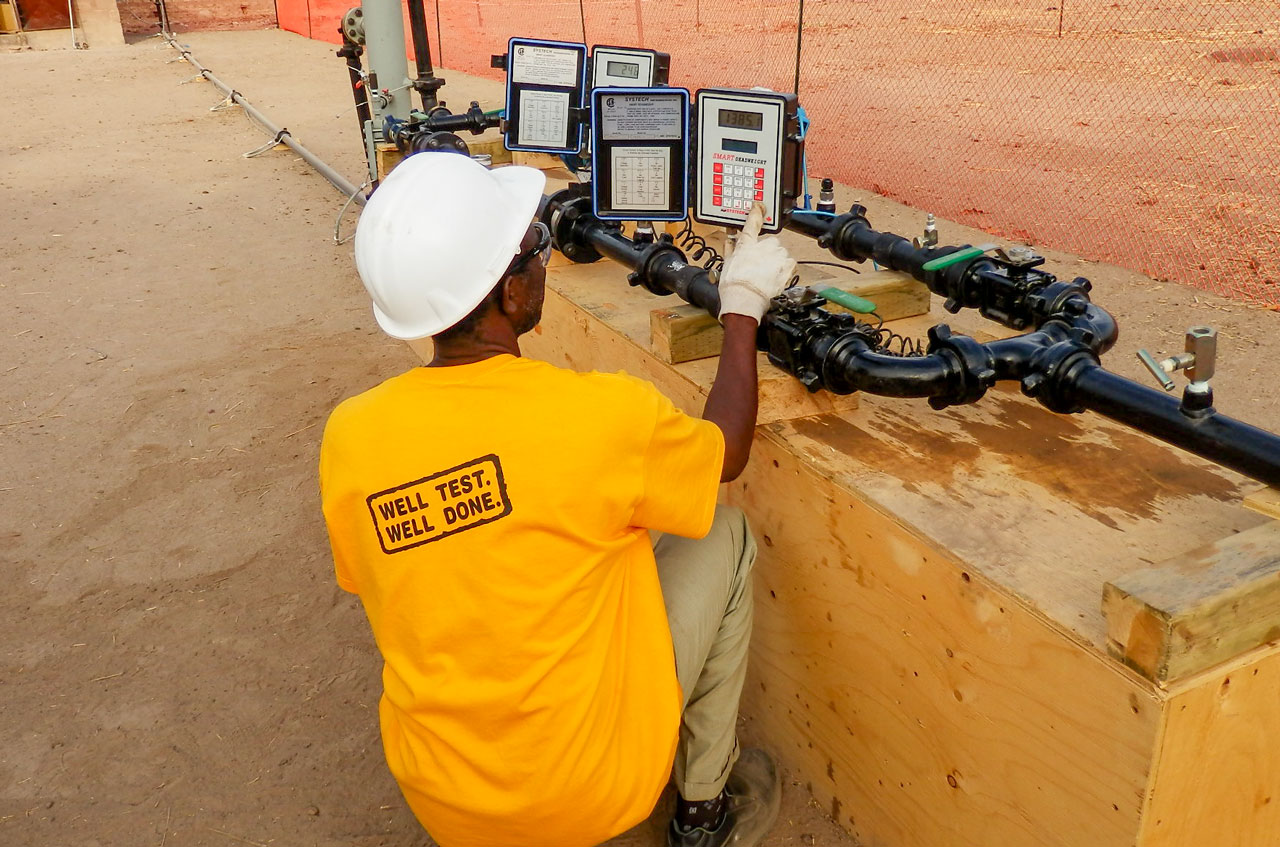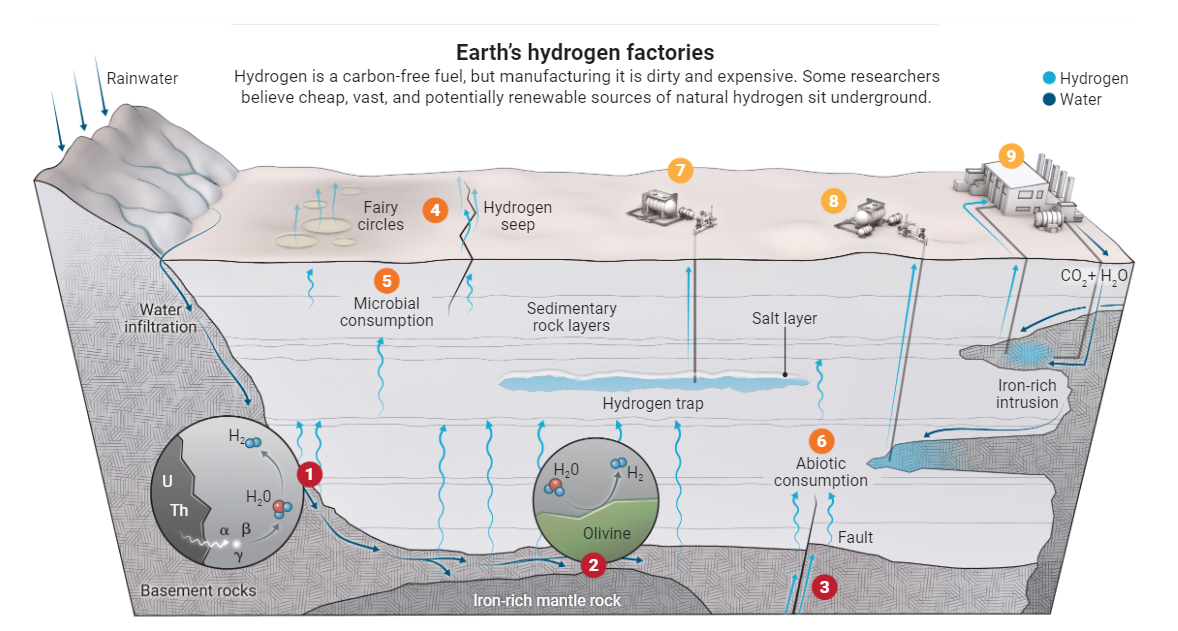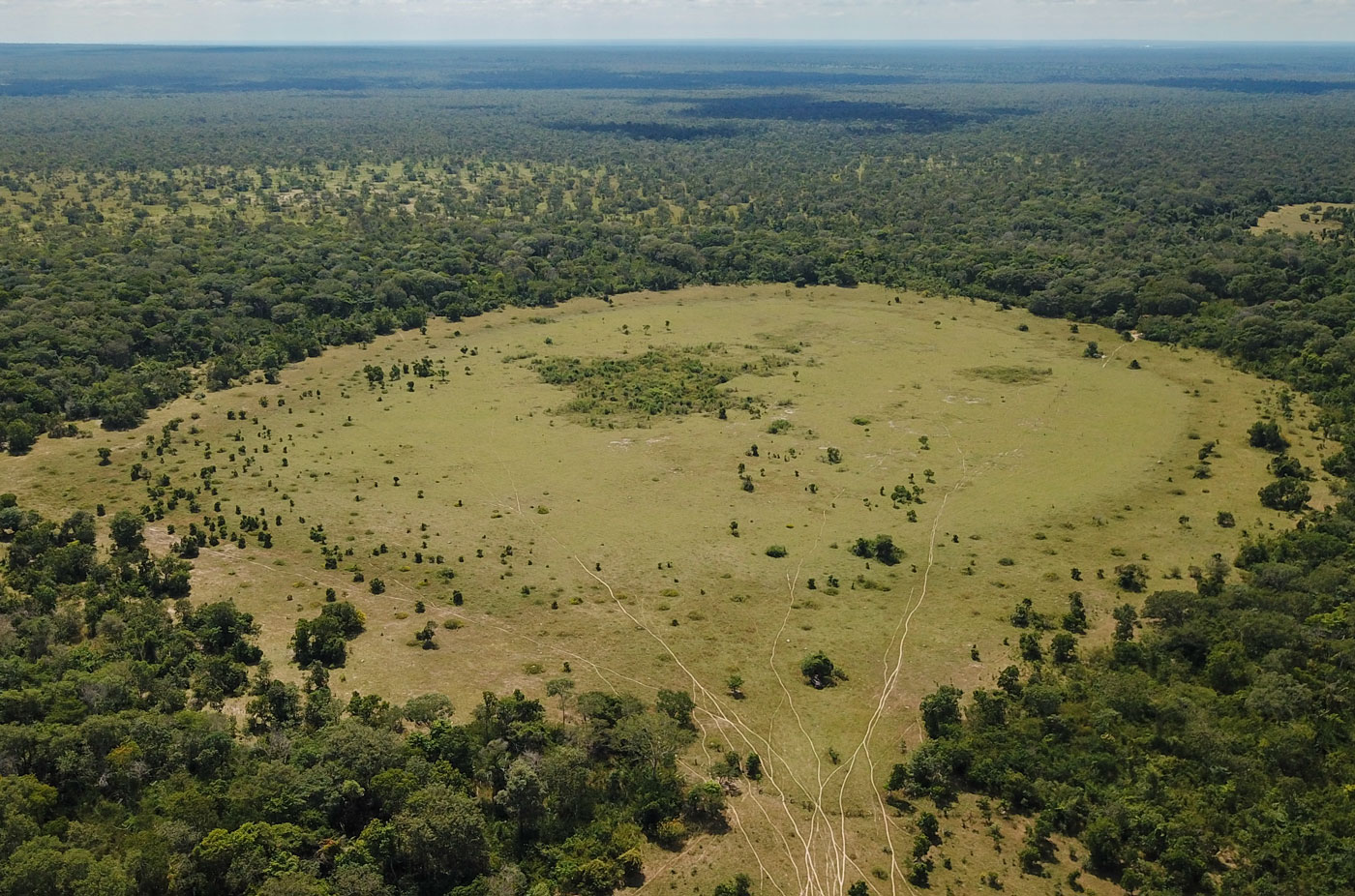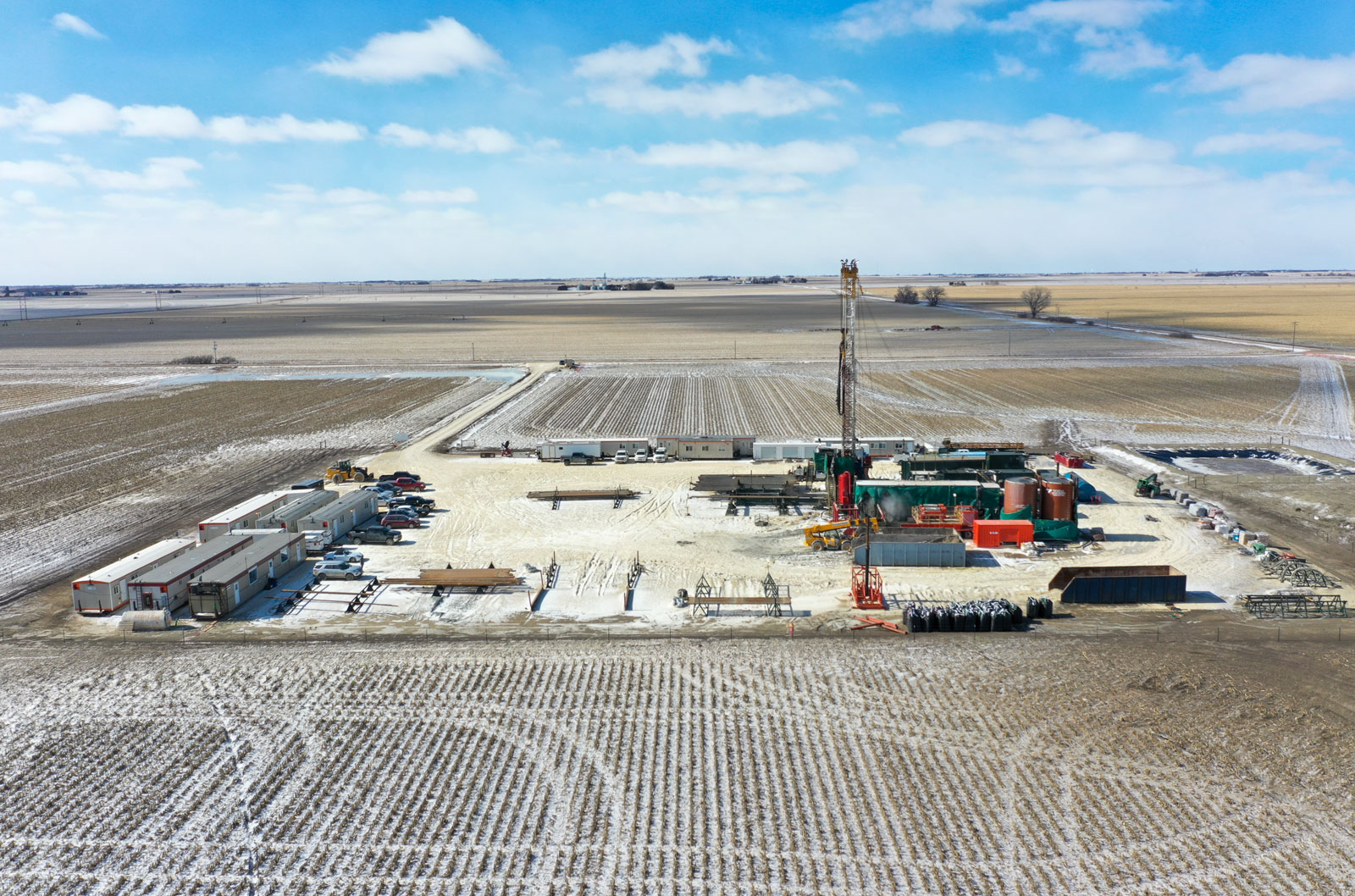IN THE SHADE of a mango tree, Mamadou Ngulo Konaré recounted the legendary event of his childhood. In 1987, well diggers had come to his village of Bourakébougou, Mali, to drill for water, but had given up on one dry borehole at a depth of 108 meters. “Meanwhile, wind was coming out of the hole,” Konaré told Denis Brière, a petrophysicist and vice president at Chapman Petroleum Engineering, in 2012. When one driller peered into the hole while smoking a cigarette, the wind exploded in his face.
“He didn’t die, but he was burned,” Konaré continued. “And now we had a huge fire. The color of the fire in daytime was like blue sparkling water and did not have black smoke pollution. The color of the fire at night was like shining gold, and all over the fields we could see each other in the light. … We were very afraid that our village would be destroyed.”
It took the crew weeks to snuff out the fire and cap the well. And there it sat, shunned by the villagers, until 2007. That was when Aliou Diallo, a wealthy Malian businessman, politician, and chair of Petroma, an oil and gas company, acquired the rights to prospect in the region surrounding Bourakébougou. “We have a saying that human beings are made of dirt, but the devil is made of fire,” Diallo says. “It was a cursed place. I said, ‘Well, cursed places, I like to turn them into places of blessing.’”
In 2012, he recruited Chapman Petroleum to determine what was coming out of the borehole. Sheltered from the 50°C heat in a mobile lab, Brière and his technicians discovered that the gas was 98% hydrogen. That was extraordinary: Hydrogen almost never turns up in oil operations, and it wasn’t thought to exist within the Earth much at all. “We had celebrations with large mangos that day,” Brière says.
Within a few months, Brière’s team had installed a Ford engine tuned to burn hydrogen. Its exhaust was water. The engine was hooked up to a 30-kilowatt generator that gave Bourakébougou its first electrical benefits: freezers to make ice, lights for evening prayers at the mosque, and a flat-screen TV so the village chief could watch soccer games. Children’s test scores also improved. “They had the lighting to learn their lessons before going to class in the morning,” Diallo says. He soon gave up on oil, changed the name of his company to Hydroma, and began drilling new wells to ascertain the size of the underground supply.
The Malian discovery was vivid evidence for what a small group of scientists, studying hints from seeps, mines, and abandoned wells, had been saying for years: Contrary to conventional wisdom, large stores of natural hydrogen may exist all over the world, like oil and gas—but not in the same places. These researchers say water-rock reactions deep within the Earth continuously generate hydrogen, which percolates up through the crust and sometimes accumulates in underground traps. There might be enough natural hydrogen to meet burgeoning global demand for thousands of years, according to a U.S. Geological Survey (USGS) model that was presented in October 2022 at a meeting of the Geological Society of America.
“When I first heard about it, I thought it was crazy,” says Emily Yedinak, a materials scientist who devoted a fellowship at the Advanced Research Projects Agency-Energy (ARPA-E) to drumming up interest in natural hydrogen. “The more that I read, the more I started to realize, wow, the science behind how hydrogen is produced is sound … I was kind of like, ‘Why is no one talking about this?’”
Since 2018, however, when Diallo and his colleagues described the Malian field in the International Journal of Hydrogen Energy, the number of papers on natural hydrogen has exploded. “It’s absolutely incredible and really exponential,” says geologist Alain Prinzhofer, lead author on the Mali paper and scientific director of GEO4U, a Brazil-based oil and gas services company that is doing more and more hydrogen work. Dozens of startups, many in Australia, are snatching up the rights to explore for hydrogen. Last year, the American Association of Petroleum Geologists formed its first natural hydrogen committee, and USGS began its first effort to identify promising hydrogen production zones in the United States. “We’re in the very beginning, but it will go fast,” says Viacheslav Zgonnik, CEO of Natural Hydrogen Energy. In 2019, the startup completed the first hydrogen borehole in the United States, in Nebraska.


Malian businessman and former presidential candidate Aliou Diallo casts his vote in 2018 (first image). Now, his company is preparing to extract hydrogen from underground deposits near the village of Bourakébougou (second image). (FIRST IMAGE) MICHELE CATTANI/AFP VIA GETTY IMAGES; (SECOND IMAGE) PAUL CHOUINARD/VERSATILE ENERGY SERVICES
The enthusiasm for natural hydrogen comes as interest in hydrogen as a clean, carbon-free fuel is surging. Governments are pushing it as a way to fight global warming, efforts that were galvanized when Russia invaded Ukraine last year and triggered a hasty search, especially in Europe, for alternatives to Russian natural gas. At the moment, all commercial hydrogen has to be manufactured, either in a polluting way, by using fossil fuels, or in an expensive way, by using renewable electricity. Natural hydrogen, if it forms sizable reserves, might be there for the taking, giving the experienced drillers in the oil and gas industry a new, environmentally friendly mission. “I believe that it has the potential to replace all fossil fuels,” Zgonnik says. “That’s a very large statement, I know.”
Critically, natural hydrogen may be not only clean, but also renewable. It takes millions of years for buried and compressed organic deposits to turn into oil and gas. By contrast, natural hydrogen is always being made afresh, when underground water reacts with iron minerals at elevated temperatures and pressures. In the decade since boreholes began to tap hydrogen in Mali, flows have not diminished, says Prinzhofer, who has consulted on the project. “Hydrogen appears, almost everywhere, as a renewable source of energy, not a fossil one,” he says.
It is still early days for natural hydrogen. Scientists don’t completely understand how it forms and migrates and—most important—whether it accumulates in a commercially exploitable way. “Interest is growing fast, but the scientific facts are still lacking,” says Frédéric-Victor Donzé, a geophysicist at Grenoble Alpes University. Big Oil is hanging back, watching while wildcatters take on the risky exploratory work. Commercialization of the Mali field has run into snags, and elsewhere only a few exploratory wells have been drilled. Donzé, who has sworn off accepting industry money, worries about hype.
Yet some scientists have become true believers. Eric Gaucher, a geochemist at the University of Bern, left a career at French oil giant Total because it wasn’t moving fast enough on hydrogen. He believes the Mali discovery might end up in the history books alongside one that happened 163 years ago in Titusville, Pennsylvania. At the time, the world knew about seeps of oil in places such as Iraq and California but was blind to the vast deposits that lay underground. Then on 27 August 1859, a nearly bankrupt prospector named Edwin Drake, working in Titusville with a steam engine and cast-iron drill pipes, struck black gold at a depth of 21 meters, and began collecting it in a bathtub. Before long, U.S. companies were harvesting millions of bathtubs of oil every day.
“I am thinking we are not very far from that with hydrogen,” Gaucher says. “We have the concept, we have the tools, the geology. … We only need people able to invest.”
EVEN THOUGH IT’S CARBON-FREE, hydrogen has its faults as an energy source. One kilogram of hydrogen holds as much energy as a gallon of gasoline (just under 4 liters). But at ambient pressures, that same kilogram of hydrogen occupies more space than the drum of a typical concrete mixing truck. Pressurized tanks can hold more but add weight and costs to vehicles. Liquefying hydrogen requires chilling it to –253°C—usually a disqualifying expense.
These storage issues—along with a lack of pipelines and distribution systems—are the main reasons why, in the race to electrify cars, batteries have won out over fuel cells, which convert hydrogen to electricity. Similarly, for domestic heating, most experts believe electric heat pumps make more sense than hydrogen furnaces.
Yet as much as half of the world’s projected energy demand will remain hard to decarbonize by switching to electricity, says Dharik Mallapragada, an energy systems researcher at the Massachusetts Institute of Technology: “That’s where hydrogen comes in.” He sees room for hydrogen to replace hydrocarbons in heavy-duty vehicles that are ill-suited to batteries: trucks, ships, and perhaps even planes, all of which can handle larger tanks and fewer fueling stations. Industries such as steel that require high-temperature combustion are another likely market. And today’s primary markets for hydrogen—it is needed to make ammonia fertilizers, for example—will continue to grow from the current 90 million tons a year.
But to be climate-friendly, hydrogen needs to be produced cleanly. Today’s hydrogen is “gray,” made by reacting methane with steam at high pressures or using fossil fuels in other ways. Those processes emit some 900 million tons of carbon dioxide every year, almost as much as global aviation. In principle, that carbon could be captured and sequestered underground, yielding “blue” hydrogen. But most hopes rest on “green” hydrogen—using renewable solar or wind power to split water molecules into oxygen and hydrogen with electrolyzers.
Governments have embraced the concept. In September 2022, the U.S. Department of Energy (DOE) said it would spend $7 billion on at least half a dozen hydrogen “hubs”: production sites for green or blue hydrogen. And in May 2022, the European Union called for 20 million tons a year of new green hydrogen—half imported, half domestic—by 2030.
But green hydrogen costs about $5 per kilogram, more than twice as much as gray hydrogen, which tends to track the price of natural gas. Cheaper electrolyzers will help—DOE is sponsoring a “moonshot” to reach $1 per kilogram within a decade. But green hydrogen would also require a huge scale-up of renewable electricity. Meeting the EU target, for instance, would require about 1000 terawatt-hours of new solar and wind installations, nearly double what Europe has now, Mallapragada says.
Pumping hydrogen out of the ground should be much cheaper, which is why proponents sometimes call the natural stuff “gold.” Brière says extraction at the Mali site, which benefits from shallow wells and nearly pure hydrogen, could be as cheap as 50 cents per kilogram. Ian Munro, CEO of Helios Aragon, a startup pursuing hydrogen in the foothills of the Spanish Pyrenees, says his break-even costs might end up between 50 and 70 cents. “If it does work, it could revolutionize energy production,” he says. “There’s a big ‘if’ there. But you’re not going to get that with green hydrogen, right? To me, that’s a bottomless pit.”
THE OIL AND GAS industry has punctured Earth with millions of wells. How could it have overlooked hydrogen for so long? One reason is that hydrogen is scarce in the sedimentary rocks that yield oil and gas, such as organic-rich shales or mudstones. When compacted and heated, the carbon molecules in those rocks consume any available hydrogen and form longer chain hydrocarbons. Any hydrogen the oil encounters as it migrates to a porous “reservoir” rock such as a sandstone tends to react to form more hydrocarbons. Hydrogen can also react with oxygen in rocks to form water or combine with carbon dioxide to form “abiotic” methane. Microbes gobble it up to make yet more methane.
Even if the hydrogen survives, geologists thought, it should not accumulate. Hydrogen is the smallest molecule of all: It can leak through minerals and even metals. If Earth were producing hydrogen, it seemed unlikely to hang around.
And so, historically, when well loggers cataloged their borehole emanations, they rarely bothered to measure for hydrogen. “The bottom line—they weren’t really looking for hydrogen,” says Geoffrey Ellis, an organic geochemist at USGS. “We weren’t looking in the right places with the right tools.”

Generation
1 Radiolysis
Trace radioactive elements in rocks emit radiation that can split water. The process is slow, so ancient rocks are most likely to generate hydrogen.
2 Serpentinization
At high temperatures, water reacts with iron-rich rocks to make hydrogen. The fast and renewable reactions, called serpentinization, may drive most production.
3 Deep-seated
Streams of hydrogen from Earth’s core or mantle may rise along tectonic plate boundaries and faults. But the theory of these vast, deep stores is controversial.
Loss mechanisms
4 Seeps
Hydrogen travels quickly through faults and fractures. It can also diffuse through rocks. Weak seeps might explain shallow depressions sometimes called fairy circles.
5 Microbes
In shallower layers of soil and rock, microbes consume hydrogen for energy, often producing methane.
6 Abiotic reactions
At deeper levels, hydrogen reacts withrocks and gases to form water, methane, and mineral compounds.
Extraction
7 Traps
Hydrogen might be tapped like oil and gas—by drilling into reservoirs trapped in porous rocks below salt deposits or other impermeable rock layers.
8 Direct
It might also be possible to tap the iron-rich source rocks directly, if they’re shallow and fractured enough to allow hydrogen to be collected.
9 Enhanced
Hydrogen production might be stimulated by pumping water into iron-rich rocks. Adding carbon dioxide would sequester it from the atmosphere, slowing climate change.
(GRAPHIC) C. BICKEL/SCIENCE; (DATA) GEOFFREY ELLIS/USGS
Yet the hints were there for those who did look. According to Zgonnik, a geochemist who recently published a review of natural hydrogen, the first scientific discussion of it dates to 1888, when Dmitri Mendeleev, the father of the periodic table, reported hydrogen seeping from cracks in a coal mine in Ukraine. Zgonnik, who was born and raised in Ukraine, says reports of hydrogen are relatively common throughout the former Soviet Union—because Soviet researchers were looking for it. They held to a now discredited theory that would have required significant amounts of natural hydrogen to produce oil from nonliving processes rather than from ancient life.
For Barbara Sherwood Lollar, a University of Toronto geochemist, the hydrogen revelation came in the 1980s, when she was a graduate student. She was taking data in mines in Canada and Finland, following up on evidence they sometimes contained flammable gases. She measured the expected hydrocarbons—some methane, some ethane—but they didn’t add up to the total mass in her samples. Finally, she realized that some contained as much as 30% hydrogen. “We didn’t even measure for it, because nobody expected hydrogen in the system,” she says.
Hundreds of hydrogen seeps have now been documented around the world. Zgonnik has come to believe hydrogen can explain even more common features: hundreds of thousands of shallow, circular depressions in the land, tens or hundreds of meters across, that go by names like fairy circles, witch rings, or water basins. “They’re widespread and very mysterious,” he says. Surveying several of these features along the U.S. East Coast, where they are called Carolina bays, Zgonnik and his colleagues found they were leaking hydrogen, and that its concentration grew with depth. Zgonnik thinks that hydrogen dissolves away minerals in underlying rocks, leading to slumping at the surface.
Vegetation within the circles can sometimes be suppressed, notes Isabelle Moretti, a geologist at the University of Pau and the Adour Region who has documented hydrogen seeping from fairy circles in Brazil, Namibia, and Australia. She speculates it might have something to do with hydrogen-loving microbes consuming other nutrients. “Maybe there is nothing left,” she says.

Hydrogen seepages might explain mysterious depressions often called fairy circles. Some are more than 1 kilometer wide in this lidar image of coastal North Carolina.VIACHESLAV ZGONNIK
Most hydrogen seeps are too feeble to be commercially exploitable. But their very existence is promising, and “really a miracle,” Gaucher says. “You have oxidant in the soil, oxygen in the atmosphere, and plenty of microbes that love to eat this hydrogen,” he says. “That it exists at all, there must be more.”
“There must be a deeper, bigger source.”
THE MAIN ENGINE of natural hydrogen production is now thought to be a set of high-temperature reactions between water and iron-rich minerals such as olivine, which dominate Earth’s mantle. One common reaction is called serpentinization, because it converts olivine into another kind of mineral called serpentinite. In the process, the iron oxidizes, grabbing oxygen atoms from water molecules and releasing hydrogen.
Scientists diving in submersibles have seen this process up close at the volcanic Mid-Atlantic Ridge, where tectonic plates are tugged apart and mantle rocks rise up to create fresh slabs of ocean crust. At a site known as Lost City (for the towering “white smoker” chimneys gushing mineral-rich hot water), researchers measured high amounts of hydrogen spewing from the sea floor. And on Iceland, which straddles the Mid-Atlantic Ridge, Moretti and her colleagues have recorded comparable hydrogen flows at some of the hot springs and geothermal wells that dot the country.
But the hope for commercial natural hydrogen lies closer to potential customers on the continents. Prospectors are looking in cratons, the ancient cores of continents, says Owain Jackson, exploration director at H2Au, a U.K.-based hydrogen company. Trapped within them are bands of iron-rich rock, called greenstone belts, which are the remnants of ocean crust that got squeezed between the cratons in ancient continental collisions. Where olivine and other minerals are buried deep enough to be hotter than 200°C, and yet still exposed to water percolating from the surface, they can produce hydrogen. Jackson, who once helped evaluate lease blocks in a region of Mali several hundred kilometers away from Bourakébougou, believes greenstone belts deep in the West African craton are driving the hydrogen production there. “We’re just a bit annoyed we gave the blocks back,” he says.
Cratons hold a second major source of iron with hydrogen-producing potential, Prinzhofer says—one that dates to an evolutionary turning point about 2.4 billion years ago. At the time, the oceans were anoxic and saturated in dissolved iron. But then, in a revolution known as the Great Oxidation Event, ocean-living microbes evolved the ability to photosynthesize. The oxygen they emitted caused the iron to fall as rust to the ocean floor, where it eventually turned to stone. Like greenstone belts, some of these deposits wound up surviving in the cratons and are known today as banded iron formations. They’re thought to hold some 60% of the world’s iron reserves.
In a 2014 paper, Sherwood Lollar and colleagues considered the makeup of Earth’s cratons and found that serpentinization should produce as much as 80% of Earth’s hydrogen. A second mechanism, radiolysis, may generate the rest. As radioactive elements in the crust such as uranium and thorium decay, they emit alpha particles, aka helium nuclei, along with other radiation that can split water molecules underground and generate an extra trickle of hydrogen.
Zgonnik favors a third and more deep-seated source: He thinks primordial hydrogen, trapped soon after the planet’s birth in its iron core, is seeping to the surface through thousands of kilometers of rock. The evidence is spotty and Zgonnik acknowledges the theory is controversial. “It goes against many paradigms,” he says.
For Prinzhofer, the question of where natural hydrogen comes from is academic. “Maybe we are all completely wrong,” he says. “It doesn’t matter for the industry.” The oil industry sprang up long before it understood oil’s origins, he says. Similarly, what matters for the natural hydrogen industry is simply whether there is enough of the stuff to go after.
At USGS, Ellis is working on answering that question. He thinks Earth produces orders of magnitude more hydrogen each year than the 90 million tons that humans manufacture. But it’s not only that flow that matters—it’s the size of the underground stock. “How much can be trapped in the subsurface that we can actually go after?” Ellis asks. “That’s a much more difficult question to answer.”
He and his USGS colleague Sarah Gelman gave it a try using a simple “box” model borrowed from the oil industry. The model accounted for impermeable rock traps of different kinds, the destructive effect of microbes, and the assumption—based on oil industry experience—that only 10% of hydrogen accumulations might ever be tapped economically. Ellis says the model comes up with a range of numbers centered around a trillion tons of hydrogen. That would satisfy world demand for thousands of years even if the green-energy transition triggers a surge in hydrogen use.
Ellis acknowledges that much of this global resource could end up being too scattered to be captured economically, like the millions of tons of gold that are dissolved in the oceans at parts per trillion levels. But that worry hasn’t stopped the hydrogen hunters.
WHILE CONFINED by one of Australia’s COVID-19 lockdowns in November 2020, Luke Titus found himself reading an obscure 1944 report: Bulletin Number 22 from the Department of Mines of the Geological Survey of South Australia. It contained an analysis of data from farmers who had banded together to search for oil, using divining rods and other questionable techniques. “There’s even reports of them dipping their hands in kerosene,” Titus says. “It’s all rather amusing.” But Titus, co-founder of a company called Gold Hydrogen, wasn’t laughing when he saw the data from one borehole, drilled in 1921 on Kangaroo Island. It had produced as much as 80% hydrogen. Another well, on the nearby Yorke Peninsula, was close to 70%.

A large fairy circle in Brazil that leaks hydrogen is curiously devoid of vegetation.ALAIN PRINZHOFER
In February 2021, when South Australia expanded its oil regulations to allow drilling for hydrogen, Titus pounced. That same month, he submitted an application to explore nearly 8000 square kilometers on the Yorke Peninsula and Kangaroo Island. He created two other paper companies to lodge applications on thousands more square kilometers. Within weeks, he had competitors. “A bunch of other businesses got wind of it,” he says.
Now, South Australia is in the middle of a hydrogen boom, at least on paper. The state is blessed with favorable geology. It’s covered by the ancient Gawler Craton, and its iron and uranium mines point to the source rocks needed for both serpentinization and radiolysis. With the ocean so close, Titus says, the rocks are sure to be water-saturated. This year he plans to conduct an airborne geophysical survey to delineate what he believes is the source rock on the Yorke Peninsula, just 1.8 kilometers down. In January, in an initial public offering on the Australian Stock Exchange, the company raised $20 million, enough to drill an exploratory well. “We’re working at the bleeding edge,” he says.
In Spain, Munro is waiting for regulations to catch up. Like Gold Hydrogen, his company Helios Aragon was founded on old but promising data: a “show” of 25% hydrogen in the Monzon-1 well, drilled in 1963 to a depth of 3.7 kilometers by the National Petroleum Company of Aragon. And like Titus, Munro believes he’s got an ideal site for hydrogen. In the core of the Pyrenees are iron-rich marine rocks, squeezed and lifted up when the Iberian Plate closed an ocean and rammed into France some 65 million years ago. Munro says deep faults channel hydrogen produced in those rocks up into a porous sandstone layer, which is capped by a tight shale.
Munro plans to drill an exploratory well in late 2024. “We believe we’ll be Europe’s first natural hydrogen well,” he says. But because his lease was awarded under Spain’s oil laws, and a 2021 climate law has since put a moratorium on new operations, he won’t be able to produce commercially until Spain carves out an exemption for hydrogen.
In the United States, the birthplace of fracking and the shale gas boom, the regulatory environment is looser. Yet, Ellis says, “For unknown reasons to me really, it hasn’t taken off in North America yet.” At USGS, he and a couple other employees are the only staff focusing on natural hydrogen. At ARPA-E, it was just Yedinak and one other person—until she left the agency a few months ago to join a clean energy startup.
Ellis is now using geophysical data to assess promising U.S. terrain for hydrogen generation. He says the United States likely sits on two rich veins. One is about 10 to 20 kilometers off the Eastern Seaboard, where iron-rich mantle rocks lie about 10 kilometers beneath the seabed. He believes hydrogen created in those rocks may be migrating up and toward shore through porous sediments—perhaps explaining why Carolina bays are found all along the East Coast. Another potential hot spot is in the Midwest, where a volcanic rift failed to split North America a billion years ago. It brought iron-rich mantle rocks close to the surface in a band from Minnesota to Kansas.
That’s the target for Zgonnik. In 2019, Natural Hydrogen Energy completed its 3.4-kilometer-deep well in the middle of a “water basin”—the local term for a fairy circle—and surrounded by corn and soybean fields. The well, near Geneva, Nebraska, sits close to deep faults that might connect it to the rocks of the failed rift zone. Zgonnik declined to say how much hydrogen the well produces, but in April 2022, the company HyTerra bought a stake in the operation. A HyTerra presentation says gas from the well “burned with a clear flame”—a sign that hydrogen is predominant.
Gaucher believes the first target for natural hydrogen explorers should be shallow accumulations that sit under impermeable caps within a kilometer or two of the surface. But if the source rocks themselves are within reach, he says, hydrogen could be collected from them directly, like oil from fracked shale; water could even be injected into the iron-rich rock to stimulate production. While collecting hydrogen, the well could also tap the geothermal energy in the heated water that returns to the surface. Best of all, if carbon dioxide were dissolved in the injected water, it could react with magnesium and calcium in the iron-containing rocks and be locked up permanently as limestone. “You’d be sequestering carbon dioxide and producing hydrogen at the same time,” Yedinak says.
The prospects are exciting. But the enthusiasm is all hypothetical at the moment. No one anywhere in the world will produce hydrogen commercially anytime soon—except, perhaps, in Mali.

In 2019, the startup Natural Hydrogen Energy drilled the first U.S. hydrogen well amid corn and soybean fields in Nebraska.VIACHESLAV ZGONNIK
ON A NOVEMBER EVENING, Diallo has arrived on a late flight into Dakar, Senegal, where he maintains a home. He lounges in a spartan room in a white tunic, taking swigs from a water bottle as he tells his story on a video call. He is one of Mali’s wealthiest citizens, having built his fortune from a gold mine and trading risky African government debt. He is also a former, and perhaps future, presidential candidate in a country now ruled by a military junta and roiled by years of struggle with Islamist terrorists.
But hydrogen is what he wants to talk about. It has been a passion project since he acquired the rights to the Bourakébougou field more than 15 years ago. “He’s a gambler,” Prinzhofer says. “He always told me, ‘I like to make incredible bets, and this is so exciting.’”
The intervening years have been difficult, and the path to commercialization slowed by the pandemic and the military coups. International sanctions meant to put pressure on the junta make it hard for Hydroma to import equipment. And few Western drilling companies are willing to work in Mali, given the constant security concerns.
Nevertheless, Hydroma is close to pumping commercial hydrogen, Diallo claims, though he won’t say how close. “Equipment is being put together now as we speak,” Brière says. Diallo says the priority is to use Bourakébougou as a filling station for fuel cells that could help electrify Mali, a country where half the population still lacks access to power.
But why stop there? Diallo wants to expand into hydrogen buses, trucks, and even trains. After that might come a fertilizer factory. Hydroma has created subsidiaries in Senegal, Mauritania, Niger, and Guinea-Bissau, and Diallo sees hydrogen driving prosperity across a region that holds 400 million people. He calls it the West African Big Green Deal. “We have proved that, beyond geological curiosity, [hydrogen] is a real natural resource that must be relied on in the future,” he says.
With 30 wells drilled across the Bourakébougou field, Brière says he can now formally assess “the prize”—oil industry jargon for the recoverable quantity in a reservoir. The field is large, he says: It contains at least 60 billion cubic meters of hydrogen, or about 5 million tons, trapped under expansive horizontal sills of ancient volcanic rock.
But the size of the prize may understate the promise. Because Earth makes hydrogen so much faster than oil, the volume of a reservoir is less meaningful, Brière says. “We don’t see that it’s a confined volume, we see that it’s always being filled and flowing and continuous.” It might be possible to tap the Bourakébougou field and others like it for many decades without depleting them. “We’ll be taking care of our generation and our children’s children’s generation,” Brière says.
The people of Bourakébougou certainly hope so. The Ford engine ran until its spark plugs gave out a few years ago, and a newly installed fuel cell—quieter and more efficient—has not yet been hooked into the village grid. Bourakébougou is dark, waiting for a hydrogen future to arrive.
With reporting by Tania Rabesandratana.
Correction, 17 February, 4:50 p.m.: An earlier version of this story misstated the name for the helium nuclei emitted by radioactive elements. They are alpha particles, not beta particles.
Correction, 23 February, 3:15 p.m.: A previous version of the story misstated the power of a generator in Mali. It was 30 kilowatts, not 300. Also, Brière’s remarks about the size of the Malian field have been clarified to reflect that his estimate is a lower bound.